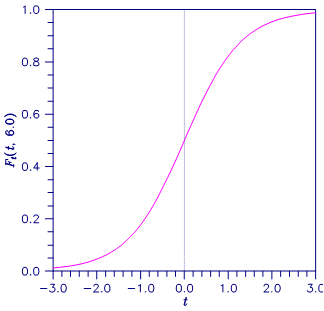tCdf¶
Evaluates the Student’s t cumulative distribution function (CDF).
Synopsis¶
tCdf (t, df)
Required Arguments¶
- float
t(Input) - Argument for which the Student’s t cumulative distribution function is to be evaluated.
- float
df(Input) - Degrees of freedom. Argument
dfmust be greater than or equal to 1.0.
Return Value¶
The probability that a Student’s t random variable takes a value less than or equal to the input t.
Description¶
Function tCdf evaluates the cumulative distribution function of a
Student’s t random variable with ν = df degrees of freedom. If
\(t^2\geq\nu\), the following identity relating the Student’s t
cumulative distribution function, \(F(t,\nu)\) to the incomplete beta
ratio function \(I_x (a,b)\) is used:
where
and
If \(t^2<\nu\), the solution space is partitioned into four algorithms as follows: If \(\nu\geq 64\) and \(t^2/\nu\leq 0.1\), a Cornish-Fisher expansion is used to evaluate the distribution function. If \(\nu<64\) and an integer and \(|t|<2.0\), a trigonometric series is used (see Abramowitz and Stegun 1964, Equations 26.7.3 and 26.7.4 with some rearrangement). If \(\nu<64\) and an integer and \(|t|\geq 2.0\), a series given by Hill (1970) that converges well for large values of t is used. For the remaining \(t^2<\nu\) cases, \(F(t|\nu)\) is calculated using the identity:
where

Figure 11.9 — Plot of \(F_t(t,6.0)\)
Example¶
This example finds the probability that a t random variable with 6 degrees of freedom is greater in absolute value than 2.447. The fact that t is symmetric about 0 is used.
from __future__ import print_function
from numpy import *
from pyimsl.stat.tCdf import tCdf
t = 2.447
df = 6.0
pr = 2 * tCdf(-t, df)
print("Pr(|t(6)| > 2.447) = %6.4f\n" % pr)
Output¶
Pr(|t(6)| > 2.447) = 0.0500